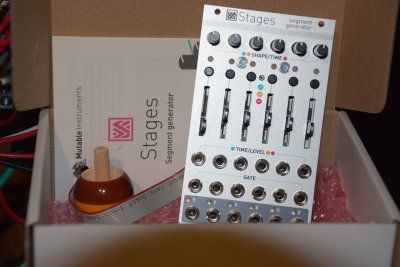bartleby
lieber nicht.
vielseitiges modul fuer allerlei huellkurven-/lfo-/sequencing-anwendungen.
flexibel: beliebig viele segmente eines moduls lassen sich zusammenschalten.
skalierbar: mehrere exemplare des moduls koennen per flachbandkabel rueckseitig zu einem grossen modul verbunden werden.
von der produktseite:

The modulation construction set
ASR envelope, complex 6-stage envelope, LFO, 4-step sequence or switched LFO: Stages can be any kind of modulation.
Not because all these behaviors have been pre-programmed in the module, but because it allows you to describe your own modulations in terms of basic operations: ramp from one voltage to another, hold a voltage at a set level, wait for a trigger and slew. With or without looping.
Whether you need one complex envelope, or several simpler modulations, Stages reconfigures itself according to which of its gate inputs are patched. There is always a role for it in your patch.
That’s it
Really, there isn’t more to the story.
Self-generating chiptunes? Very weird LFO shapes? Random gate delay? Stages probably does strange and wonderful things when patched in a certain way.
Flexible input/output layout
The module detects the presence of jacks on its gate inputs to group its segments: whether it is configured as a complex 6-stage envelope, or 6 individual envelopes, or 3+3, 2+4… depends simply on how you patch it. Dummy patch cables might come handy!
When used as a multi-segment envelope, a segment activation signal is produced on all secondary outputs - for example to trigger an external event when an ADSR envelope enters its decay, sustain or release stages.
In case more than 6 segments are required, up to six modules can be chained together thanks to a connector at the back of the module.
Three segment types
flexibel: beliebig viele segmente eines moduls lassen sich zusammenschalten.
skalierbar: mehrere exemplare des moduls koennen per flachbandkabel rueckseitig zu einem grossen modul verbunden werden.
von der produktseite:

The modulation construction set
ASR envelope, complex 6-stage envelope, LFO, 4-step sequence or switched LFO: Stages can be any kind of modulation.
Not because all these behaviors have been pre-programmed in the module, but because it allows you to describe your own modulations in terms of basic operations: ramp from one voltage to another, hold a voltage at a set level, wait for a trigger and slew. With or without looping.
Whether you need one complex envelope, or several simpler modulations, Stages reconfigures itself according to which of its gate inputs are patched. There is always a role for it in your patch.
That’s it
Really, there isn’t more to the story.
Self-generating chiptunes? Very weird LFO shapes? Random gate delay? Stages probably does strange and wonderful things when patched in a certain way.
Flexible input/output layout
The module detects the presence of jacks on its gate inputs to group its segments: whether it is configured as a complex 6-stage envelope, or 6 individual envelopes, or 3+3, 2+4… depends simply on how you patch it. Dummy patch cables might come handy!
When used as a multi-segment envelope, a segment activation signal is produced on all secondary outputs - for example to trigger an external event when an ADSR envelope enters its decay, sustain or release stages.
In case more than 6 segments are required, up to six modules can be chained together thanks to a connector at the back of the module.
Three segment types
- Ramp segments go from one voltage to another, in a CV-controlled amount of time, with an adjustable curve (accelerating, uniform, decelerating). They are the building block used for the attack, decay or release segments in envelopes… or for LFOs.
- Hold segments stay at a constant (but CV-controllable) voltage for a programmable amount of time. They serve as the sustain or hold segments in envelopes.
- Step segments glide to a target (CV-controllable) voltage, then stay at this voltage for a certain amount of time until a trigger is received. They are the main ingredient for step sequences, but also for building sequential switches or a sample-and-hold.
Zuletzt bearbeitet:
 , mein Rack wird irgendwie immer "mutabler"....
, mein Rack wird irgendwie immer "mutabler"....